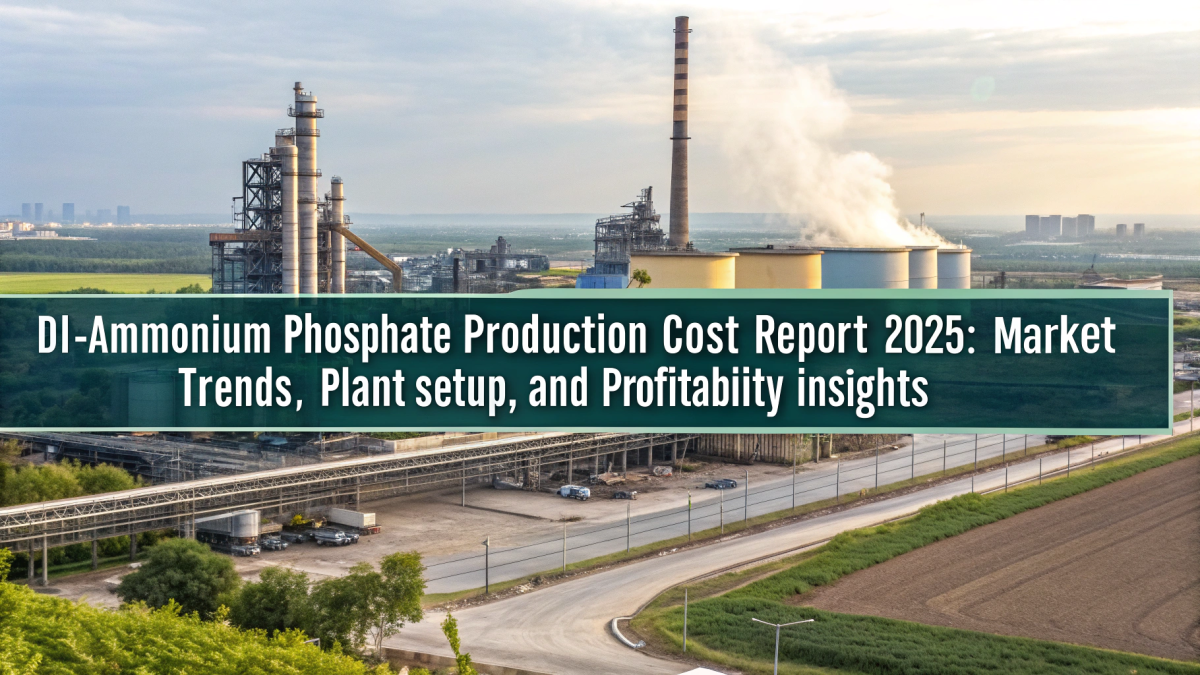
Di-Ammonium Phosphate Production Cost Report 2025: Market Trends, Plant Setup, And Profitability Insights
Di-ammonium Phosphate (DAP) is a widely used inorganic salt with the chemical formula (NH4)2HPO4, produced by reacting ammonia with phosphoric acid. It is one of the most popular phosphorus fertilizers in agriculture, providing essential nitrogen and phosphorus nutrients that support root development and overall plant growth. DAP appears as a white crystalline granule, is water-soluble, and is valued for its high nutrient content, easy handling, and effectiveness in improving crop yields across diverse soils and climates.
Setting up a Di-ammonium Phosphate (DAP) production plant involves sourcing key raw materials such as ammonia and phosphoric acid, along with designing a robust process flow that includes neutralization, granulation, drying, and screening systems. The plant requires specialized equipment like reactors, granulators, and scrubbers to ensure efficient production and compliance with environmental standards. Careful attention must be given to waste management, energy use, and safety protocols. With agriculture driving global demand, establishing a DAP plant can be a profitable investment while supporting food security and sustainable farming practices.
IMARC Group's report, titled “Di-ammonium Phosphate Production Cost Analysis 2025: Industry Trends, Plant Setup, Machinery, Raw Materials, Investment Opportunities, Cost and Revenue,” provides a complete roadmap for setting up a di-ammonium phosphate production plant. It covers a comprehensive market overview to micro-level information such as unit operations involved, raw material requirements, utility requirements, infrastructure requirements, machinery and technology requirements, manpower requirements, packaging requirements, transportation requirements, etc.
Request for a Sample Report: https://www.imarcgroup.com/diammonium-phosphate-dap-manufacturing-plant-project-report/requestsample
Di-ammonium Phosphate Industry Outlook 2025
The Di-ammonium Phosphate (DAP) industry is poised for steady growth in 2025, driven by its vital role as a high-nitrogen, high-phosphorus fertilizer supporting global agriculture. Rising food demand, soil nutrient management, and sustainable farming practices are fueling market expansion. Additionally, advancements in fertilizer production, government support for crop yield improvement, and increasing adoption in emerging economies make DAP a key player in the agrochemical sector. With strong demand projections, the industry outlook highlights opportunities for innovation, efficient supply chains, and environmentally responsible production to meet the evolving needs of farmers worldwide.
Key Insights for Di-ammonium Phosphate Production Plant Setup
Detailed Process Flow
-
Product Overview
Unit Operations Involved
Mass Balance and Raw Material Requirements
Quality Assurance Criteria
Technical Tests
Project Details, Requirements and Costs Involved:
-
Land, Location and Site Development
Plant Layout
Machinery Requirements and Costs
Raw Material Requirements and Costs
Packaging Requirements and Costs
Transportation Requirements and Costs
Utility Requirements and Costs
Human Resource Requirements and Costs
Capital Expenditure (CapEx) and Operational Expenditure (OpEx) Analysis:
Project Economics:
-
Capital Investments
Operating Costs
Expenditure Projections
Revenue Projections
Taxation and Depreciation
Profit Projections
Financial Analysis
Profitability Analysis:
-
Total Income
Total Expenditure
Gross Profit
Gross Margin
Net Profit
Net Margin
Speak to an Analyst for Customized Report: https://www.imarcgroup.com/request?type=report&id=23079&flag=C
Key Cost Components of Setting Up a Di-ammonium Phosphate Plant
-
Raw Materials : Costs for phosphate rock, ammonia, and sulfur.
Equipment : Investment in reactors, heat exchangers, and granulators.
Labor : Wages for skilled and unskilled workforce.
Utilities : Expenses for water, electricity, and steam.
Land and Infrastructure : Purchase or lease of land, roads, and facilities.
Regulatory Compliance : Costs related to permits and environmental assessments.
Maintenance : Ongoing costs for equipment upkeep and repairs.
Contingency Fund : Reserve for unexpected expenses.
Economic Trends Influencing Di-ammonium Phosphate Plant Setup Costs 2025
-
Raw Material Prices : Fluctuations in phosphate rock and ammonia prices impact production costs.
Energy Costs : Rising energy prices affect operational expenses for DAP plants.
Regulatory Changes : New environmental regulations can increase compliance costs.
Labor Market Dynamics : Labor shortages or wage increases influence overall setup expenses.
Technological Advancements : Innovations can reduce costs but may require initial investment.
Global Demand : Increasing agricultural demand for fertilizers drives higher setup costs.
Supply Chain Disruptions : Geopolitical tensions or pandemics can lead to increased logistics costs.
Challenges and Considerations for Investors
-
Market Volatility : Prices can fluctuate due to supply and demand dynamics.
Environmental Regulations : Compliance with environmental laws may increase operational costs.
Supply Chain Disruptions : Natural disasters or geopolitical issues can impact availability.
Quality Control : Variability in product quality affects agricultural outcomes.
Competition : Intense competition from alternative fertilizers may pressure margins.
Technological Advancements : Innovations in fertilizer production can disrupt market balance.
Global Demand Trends : Shifts in agricultural practices influence DAP consumption.
Buy Now: https://www.imarcgroup.com/checkout?id=23079&method=1911
Conclusion
This report aims to serve as a practical guide for entrepreneurs, investors, and industrial planners exploring opportunities in di-ammonium phosphate production. By understanding the cost structure, market dynamics, and operational challenges, stakeholders can make informed decisions and devise sustainable strategies for entry and expansion in the sector.
About Us: IMARC Group is a global management consulting firm that helps the world's most ambitious changemakers to create a lasting impact. The company excel in understanding its client's business priorities and delivering tailored solutions that drive meaningful outcomes. We provide a comprehensive suite of market entry and expansion services. Our offerings include thorough market assessment, feasibility studies, company incorporation assistance, factory setup support, regulatory approvals and licensing navigation, branding, marketing and sales strategies, competitive landscape, and benchmarking analyses, pricing and cost research, and procurement research.
Contact Us:
IMARC Group
134 N 4th St. Brooklyn, NY 11249, USA
Email: sales[@]imarcgroup.com
Tel No:(D) +91 120 433 0800
United States: (+1-201971-6302)
Legal Disclaimer:
MENAFN provides the
information “as is” without warranty of any kind. We do not accept
any responsibility or liability for the accuracy, content, images,
videos, licenses, completeness, legality, or reliability of the information
contained in this article. If you have any complaints or copyright
issues related to this article, kindly contact the provider above.


















Comments
No comment